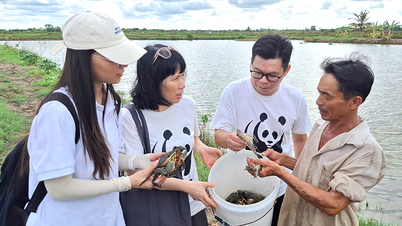To achieve the winter-spring rice yield target, in addition to focusing on directing the good implementation of technical stages such as sowing time, seed structure, water regulation, and care techniques, timely and effective detection and prevention of harmful pests and diseases play an important role.
At this time, winter-spring rice is in the seedling and tillering stage, but due to the influence of the weather, it is susceptible to damage from thrips, leaf rollers, mice and golden apple snails. To ensure rice growth and development, localities need to proactively monitor and prevent pests and diseases.
Rats , pests and diseases
In the 2025 winter-spring crop, Mr. Bui Van An in Hoa An commune (Phu Hoa district) sowed nearly 1 hectare of rice. After visiting the field, he discovered that his family's rice field was damaged by rats, and golden apple snails caused minor damage, which made him very worried. According to Mr. An, the reason for the increase in rats could be due to the weather, diverse food, and the introduction of many rice varieties to the field, including high-quality rice varieties such as fragrant rice, which are also more attractive.
“To proactively prevent rats from destroying rice, he manually hunts and catches rats, using fences around the field and wire traps. In addition, he also uses chemicals to kill rats, treat golden apple snails and thrips to help the rice grow well. He hopes that by the end of the harvest, the rice will yield 70-85 quintals/ha,” said Mr. An.
Rats destroying rice also occurred in Tuy An, Tay Hoa, Song Hinh districts, Dong Hoa town, and Tuy Hoa city. According to many people, in 2024, due to no major floods, rats reproduced rapidly in almost all fields, destroying rice that was in the development stage.
Ms. Dang Thi Phin in Hoa Tan Dong Commune (Dong Hoa Town) said: Rats have been biting and destroying a lot of her family's rice fields. At first, she used plastic bags to cover the fields to keep the rats from destroying the rice, but then the rats still invaded. Many rice rows in the tillering stage were bitten by rats, leading to broken roots and dead plants. Not only rats, but golden apple snails also cause damage. Therefore, in recent days, she and her husband have had to take turns going to the fields to check on the rice fields, find ways to kill rats and catch snails to minimize damage to rice yields.
In recent days, Mr. Duong Cong Toan in Xuan Phu Ward (Song Cau Town) has also been restless as his family's rice fields have been damaged by small leaf rollers. He has taken many measures based on experience and instructions from plant protection officers, but the pests have not decreased much. Mr. Toan worriedly said: If pesticides are not used continuously, pests will be difficult to reduce, and may even spread; if they are overused, the quality will be affected, and the product will be unsafe.
Prevent the spread
According to statistics from the Phu Yen Department of Cultivation and Plant Protection, this winter-spring crop, the whole province sowed more than 26,600 hectares of rice. Currently, rice plants in the seedling - tillering stage are being damaged by harmful agents. Of which, rats damaged a total area of more than 311 hectares, golden apple snails damaged 50 hectares, thrips damaged 88 hectares, small leaf rollers and root nematodes damaged 6 hectares... In general, the area damaged by harmful agents increased compared to the previous period.
In Tay Hoa district, through monitoring, rats appeared and caused scattered damage below the infection level of 250 hectares and thrips damaged 85 hectares, the district's Department of Agriculture and Rural Development directed professional staff, communes and towns to proactively monitor the fields to promptly handle and guide farmers on remedial measures.
Ms. Nguyen Thi Huyen Tran, Head of the Department of Agriculture and Rural Development of Tay Hoa district, said: Experience over the years shows that if rats are not exterminated from the beginning of the crop, they will reproduce quickly and destroy the rice plants when they have just sprouted new leaves. Therefore, from the beginning of the crop, the district has proactively launched a campaign to exterminate rats; instructing farmers to make the most of local organic fertilizers to fertilize the fields and improve soil fertility. When diseases appear, farmers need to keep water in the fields, isolate fields with high disease rates; mobilize forces to spray according to the 4-right principle (right time, right type, right way, right amount) with specific pesticides to control diseases.
Mr. Nguyen Van Minh, Head of the Department of Cultivation and Plant Protection, said: The current situation of pests and diseases spreading on winter-spring rice, in addition to objective reasons, is that field management in many localities has not been done well. Untimely disease prevention and especially the use of chemical fertilizers that do not follow instructions, using too much nitrogen, causing the plants to be green and thin-leafed, with poor resistance, will affect the yield and quality of rice grains.
According to Mr. Minh, to manage the disease well, the department has issued an official dispatch guiding localities in caring for and preventing pests and diseases in crops. In addition, the Department of Agriculture also recommends that when spraying pesticides, farmers should not mix them with foliar fertilizers to limit disease outbreaks. When using chemicals, farmers should spray in rotation different types of pesticides to prevent rice blast such as: Beam 75 WP, Filia 525 SE, Flash 75 WP... to avoid continuous use of one type of pesticide, which will make the disease resistant to the drug.
To improve the effectiveness of pest control, localities need to provide timely information on the situation of pests in specific areas so that farmers know and can take preventive measures. In necessary cases, districts, towns and cities need to proactively allocate reserve budgets to support materials and means to help farmers prevent pests and avoid widespread outbreaks.
Ms. Dang Thi Thuy, Deputy Director of Department of Agriculture and Rural Development |
NGOC HAN
Source: https://baophuyen.vn/82/325030/chu-dong-phong-tru-sau-benh-hai-lua-dong-xuan.html




![[Photo] General Secretary To Lam receives Chief of the Central Office of the Lao People's Revolutionary Party](https://vphoto.vietnam.vn/thumb/1200x675/vietnam/resource/IMAGE/2025/5/30/140435f4b39d4599a3d17975dfb444c5)
![[Photo] A delegation of 100 journalists from the Vietnam Journalists Association visits the soldiers and people of Truong Sa island district.](https://vphoto.vietnam.vn/thumb/1200x675/vietnam/resource/IMAGE/2025/5/30/0984a986227d4e988177f560d2e1563e)
![[Photo] National Conference "100 years of Vietnamese Revolutionary Press accompanying the glorious cause of the Party and the nation"](https://vphoto.vietnam.vn/thumb/1200x675/vietnam/resource/IMAGE/2025/5/30/1cf6cd5c8a934ebfa347028dcb08358c)
![[Photo] Journalists moved to tears at the Memorial Service for the soldiers who died in Gac Ma](https://vphoto.vietnam.vn/thumb/1200x675/vietnam/resource/IMAGE/2025/5/30/9454613a55c54c16bf8c0efa51883456)




















































































Comment (0)